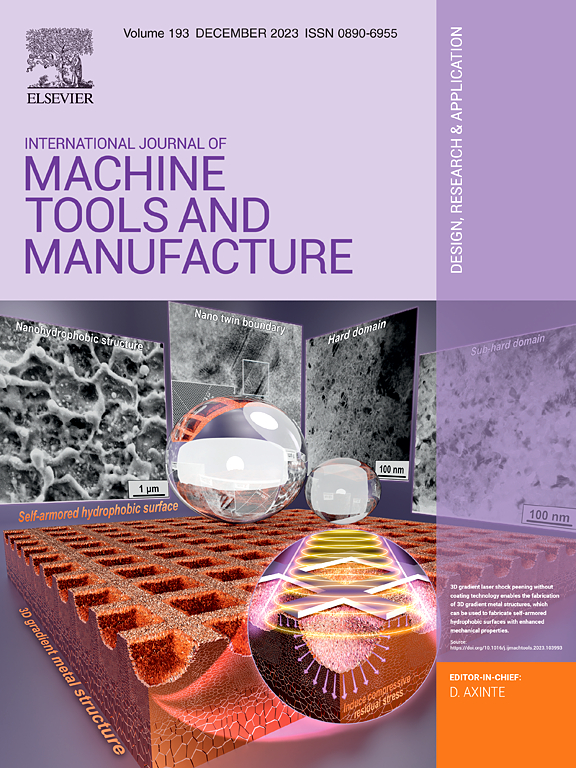Covalently armoring graphene on diamond abrasives with unprecedented wear resistance and abrasive performance
IF 18.8
1区 工程技术
Q1 ENGINEERING, MANUFACTURING
International Journal of Machine Tools & Manufacture
Pub Date : 2025-02-03
DOI:10.1016/j.ijmachtools.2025.104254
引用次数: 0
Abstract
Next-generation semiconductor materials, including diamond, SiC, and GaN, offer significant advantages for high-power devices. However, the high-performance polishing of these ultrahard materials is limited by insufficient grit wear resistance and low-quality material removal with conventional diamond abrasives. In this study, we report robust integration of flexible graphene armor on diamond abrasives through covalent interfacial bonding for high-efficiency high-quality polishing of ultrahard materials. Utilizing a novel Ga-diamond cellular wetting strategy followed by vacuum heating treatment, we achieved highly scalable production of graphene-armored diamond abrasives with a productivity of 1 kg/L. The employment of graphene-armored diamond abrasives simultaneously improved the polishing efficiency and polishing quality, enabling damage-free atomic-level surface finish and an atomic attrition rate 5 times greater than conventional diamond abrasives. This efficient material attrition is attributed to the robust combination of exceptional intrinsic wear resistance, bonding capability and high flexibility of graphene with the ultrahigh hardness of diamond. The synergy of soft graphene and hard diamond grit provides sufficient material removal capability while simultaneously reducing the polishing damage that is often induced by brittle fracture and extreme local contact pressure with conventional diamond abrasives. This work offers a novel solution that enables high-efficiency high-quality polishing of ultrahard materials with a room-temperature, chemical-free and low-cost mechanical polishing procedure.

在金刚石磨料上共价镀覆石墨烯,具有前所未有的耐磨性和磨料性能
下一代半导体材料,包括金刚石、SiC和GaN,为高功率器件提供了显著的优势。然而,这些超硬材料的高性能抛光受到常规金刚石磨料的磨粒耐磨性不足和低质量材料去除的限制。在这项研究中,我们报告了柔性石墨烯装甲通过共价界面键在金刚石磨料上的强大集成,用于超硬材料的高效高质量抛光。利用一种新型的ga -金刚石细胞润湿策略,然后进行真空加热处理,我们实现了石墨烯装甲金刚石磨料的高度可扩展生产,生产率为1 kg/L。石墨烯装甲金刚石磨料的使用同时提高了抛光效率和抛光质量,实现了无损伤的原子级表面光洁度,原子磨损率是常规金刚石磨料的5倍。这种高效的材料摩擦是由于石墨烯优异的内在耐磨性、结合能力和高柔韧性与金刚石的超高硬度的强大结合。软石墨烯和硬金刚石磨粒的协同作用提供了足够的材料去除能力,同时减少了传统金刚石磨料通常由脆性断裂和极端局部接触压力引起的抛光损伤。这项工作提供了一种新颖的解决方案,可以使用室温、无化学物质和低成本的机械抛光程序对超硬材料进行高效、高质量的抛光。
本文章由计算机程序翻译,如有差异,请以英文原文为准。
求助全文
约1分钟内获得全文
求助全文
来源期刊
CiteScore
25.70
自引率
10.00%
发文量
66
审稿时长
18 days
期刊介绍:
The International Journal of Machine Tools and Manufacture is dedicated to advancing scientific comprehension of the fundamental mechanics involved in processes and machines utilized in the manufacturing of engineering components. While the primary focus is on metals, the journal also explores applications in composites, ceramics, and other structural or functional materials. The coverage includes a diverse range of topics:
- Essential mechanics of processes involving material removal, accretion, and deformation, encompassing solid, semi-solid, or particulate forms.
- Significant scientific advancements in existing or new processes and machines.
- In-depth characterization of workpiece materials (structure/surfaces) through advanced techniques (e.g., SEM, EDS, TEM, EBSD, AES, Raman spectroscopy) to unveil new phenomenological aspects governing manufacturing processes.
- Tool design, utilization, and comprehensive studies of failure mechanisms.
- Innovative concepts of machine tools, fixtures, and tool holders supported by modeling and demonstrations relevant to manufacturing processes within the journal's scope.
- Novel scientific contributions exploring interactions between the machine tool, control system, software design, and processes.
- Studies elucidating specific mechanisms governing niche processes (e.g., ultra-high precision, nano/atomic level manufacturing with either mechanical or non-mechanical "tools").
- Innovative approaches, underpinned by thorough scientific analysis, addressing emerging or breakthrough processes (e.g., bio-inspired manufacturing) and/or applications (e.g., ultra-high precision optics).

 求助内容:
求助内容: 应助结果提醒方式:
应助结果提醒方式:


